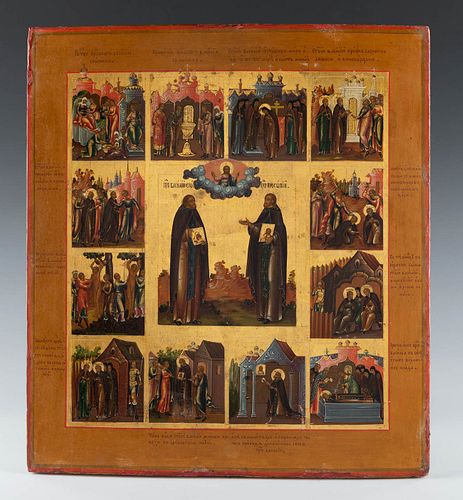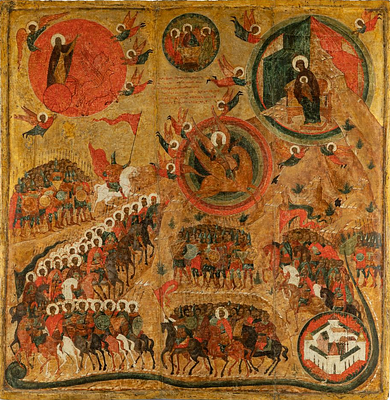Russian school, workshops of the Old Believers, Moscow, 19th c. "Venerable Saints Basil and Prokopiy, his disciple with 12 hagiographic scenes". Tempe
Lot 28
About Seller
Setdart Auction House
Carrer Aragó 346
Barcelona
Spain
Setdart Subastas was born in 2004 and is currently the first online art auction in Spain with solidity, prestige and reliability guaranteed by our more than 60,000 users. Setdart has a young, dynamic and enterprising team ready to successfully manage the purchase and sale of art works through custom...Read more
Estimate:
EUR€3,000 - EUR€3,500
$3,125 - $3,645.83
Absentee vs Live bid
Two ways to bid:
- Leave a max absentee bid and the platform will bid on your behalf up to your maximum bid during the live auction.
- Bid live during the auction and your bids will be submitted real-time to the auctioneer.
Bid Increments
| Price | Bid Increment |
|---|---|
| EUR€0 | EUR€10 |
| EUR€200 | EUR€25 |
| EUR€500 | EUR€50 |
| EUR€1,000 | EUR€100 |
| EUR€3,000 | EUR€200 |
| EUR€5,000 | EUR€500 |
| EUR€10,000 | EUR€1,000 |
| EUR€20,000 | EUR€2,000 |
| EUR€50,000 | EUR€5,000 |
About Auction
By Setdart Auction House
Sep 23, 2021
Set Reminder
2021-09-23 10:00:00
2021-09-23 10:00:00
America/New_York
Bidsquare
Bidsquare : RUSSIAN ICONS
https://www.bidsquare.com/auctions/setdart-auction-house/russian-icons-7431
Setdart Auction House sofia@setdart.com
Setdart Auction House sofia@setdart.com
- Lot Description
Russian school, workshops of the Old Believers, Moscow, 19th c. "Venerable Saints Basil and Prokopiy, his disciple with 12 hagiographic scenes". Tempera, gold leaf on panel. Measurements: 44,5 x 40 cm. Saint Basil (not to be confused with Basil the Great), who is to the left of the central register of the icon, lived during the reign of Leo the Iconoclast. Leaving the world with its temptations, he entered a monastery and led a virtuous monastic life. When there was persecution against the veneration of sacred icons, St. Basil bravely resisted the iconoclasts. For this he was imprisoned and subjected to many tortures, but in spite of this Basil rejected the heretical teaching of the iconoclasts and, together with St. Procopius, who stands to our right, defended the truth to the shedding of blood. Like the monk Prokopius, St. Basil, he was scourged all over his body; then he was imprisoned in the prison, where he languished for a long time, until the death of the pious King Leo. On the death of the torturer, the monk Basil was released together with St. Prokopius and other confessors and lived as before in works of fasting, converting many to the orthodox faith and leading them to a virtuous life. After several years of pious life, he was granted a blessed rest and with prayer, thanksgiving and unspeakable joy he went to the Lord, whom he had loved since his early childhood. The present icon has a series of twelve images, which relate the life of St. Basil from his birth to his death. Hagiographic icons are a typology of Orthodox iconography, and should be read as if they were a book, starting from the upper left corner to the lower right corner. All the images are accompanied by inscriptions on the outer border of the icon, explaining what is happening in each image. Together with the two-fingered blessing, which some saints have, and the name of Jesus Christ as "IC XC", it indicates that this is an icon made in the workshops of the Old Believers.
- Shipping Info
-
In-house shipping available. Please inquire at admin@setdart.com.
-
- Buyer's Premium



 EUR
EUR CAD
CAD AUD
AUD GBP
GBP MXN
MXN HKD
HKD CNY
CNY MYR
MYR SEK
SEK SGD
SGD CHF
CHF THB
THB

















